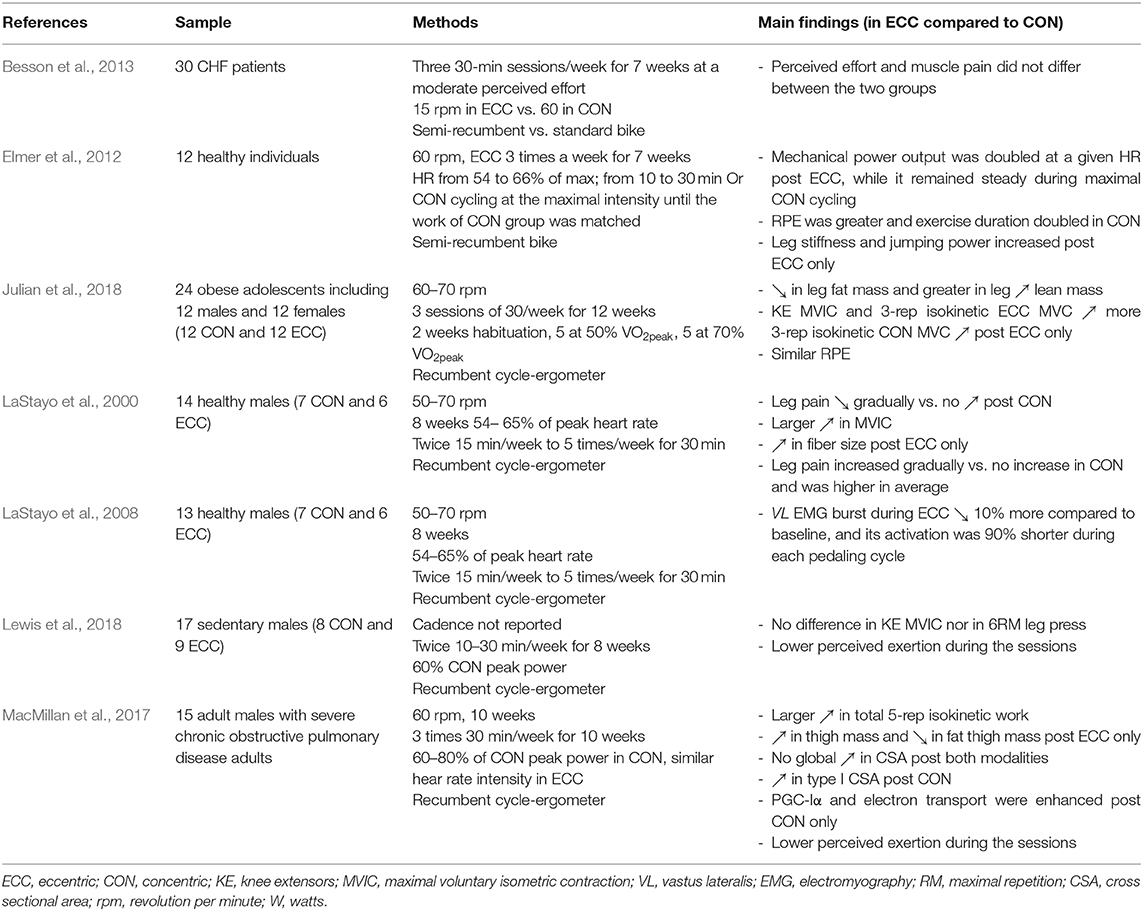- 1CAPS UMR1093, Institut National de la Santé et de la Recherche Médicale (INSERM), Université de Bourgogne-Franche Comté, Dijon, France
- 2INSERM CIC 1432, Plateforme d'Investigation Technologique, University Hospital of Dijon, Dijon, France
- 3Neural Control of Movement Group, Faculty of Science, Medicine and Health, School of Medicine, Illawarra Health and Medical Research Institute, University of Wollongong, Wollongong, NSW, Australia
A Corrigendum on
Neuromuscular and Perceptual Responses to Sub-Maximal Eccentric Cycling
by Clos, P., Laroche, D., Stapley, P. J., and Lepers, R. (2019). Front. Physiol. 10:354. doi: 10.3389/fphys.2019.00354
In the original article, there was a mistake in Table 2 as published. We wrote that in LaStayo et al. (2000), leg pain gradually increased, while it gradually decreased. The correct statement for LaStayo et al. (2000) is leg pain gradually decreased while it gradually increased. The corrected Table 2 appears below.
In the original article, there were two errors. We wrote that in LaStayo et al. (2000), leg pain gradually increased, while it gradually decreased.
A correction has been made to Results, Adaptations to Training in ECC Cycling, Perceptual Adaptation:
Leg pain was reported as “very little” though decreased gradually throughout weeks of ECC cycling training while it was inexistent in the CON group at the same heart rate intensity (LaStayo et al., 2000). In their experiment described above, Elmer et al. (2012) reported a lower average rate of perceived effort during ECC than CON cycling training, despite having completed the same total mechanical work.
We wrote that in LaStayo et al. (2000), leg pain gradually increased, while it gradually decreased.
A correction has been made to Discussion, Paragraph two:
Chronic ECC cycling was found to be more advantageous than CON cycling in terms of muscle hypertrophy, at the same heart rate intensity or metabolic load. The extent of improvement in performance primarily involving the neuromuscular system seems essentially to depend upon the mechanical workload at which the cycling exercise is performed, which itself depends on the criterion used to match exercise intensity between the two contraction regimes. Finally, the single finding concerning the chronic perceptual responses to ECC cycling indicates a gradual decrease in leg pain compared to no reported change during CON cycling at the same heart rate intensity.
The authors apologize for these errors and state that this does not change the scientific conclusions of the article in any way. The original article has been updated.
References
Besson, D., Joussain, C., Gremeaux, V., Morisset, C., Laurent, Y., Casillas, J.-M., et al. (2013). Eccentric training in chronic heart failure: feasibility and functional effects. Results of a comparative study. Ann. Phys. Rehabil. Med. 56, 30–40. doi: 10.1016/j.rehab.2013.01.003
Elmer, S., Hahn, S., McAllister, P., Leong, C., and Martin, J. (2012). Improvements in multi-joint leg function following chronic eccentric exercise. Scand. J. Med. Sci. Sports 22, 653–661. doi: 10.1111/j.1600-0838.2011.01291.x
Julian, V., Thivel, D., Miguet, M., Pereira, B., Costes, F., Coudeyre, E., et al. (2018). Eccentric cycling is more efficient in reducing fat mass than concentric cycling in adolescents with obesity. Scand. J. Med. Sci. Sports 29, 4–15. doi: 10.1111/sms.13301
LaStayo, P., Pifer, J., Pierotti, D., and Lindstedt, S. (2008). Electromyographic adaptations elicited by submaximal exercise in those naive to and in those adapted to eccentric exercise: a descriptive report. J. Strength Cond. Res. 22, 833–838. doi: 10.1519/JSC.0b013e31816a5825
LaStayo, P. C., Pierotti, D. J., Pifer, J., Hoppeler, H., and Lindstedt, S. L. (2000). Eccentric ergometry: increases in locomotor muscle size and strength at low training intensities. Am. J. Physiol. Regul. Integr. Comp. Physiol. 278, R1282–R1288. doi: 10.1152/ajpregu.2000.278.5.R1282
Lewis, M. C., Peoples, G. E., Groeller, H., and Brown, M. A. (2018). Eccentric cycling emphasising a low cardiopulmonary demand increases leg strength equivalent to workload matched concentric cycling in middle age sedentary males. J. Sci. Med. Sport 21, 1238–1243. doi: 10.1016/j.jsams.2018.05.009
MacMillan, N. J., Kapchinsky, S., Konokhova, Y., Gouspillou, G., de Sousa Sena, R., Jagoe, R. T., et al. (2017). Eccentric ergometer training promotes locomotor muscle strength but not mitochondrial adaptation in patients with severe chronic obstructive pulmonary disease. Front. Physiol. 8:114. doi: 10.3389/fphys.2017.00114
Keywords: negative work, pedaling, perception, corticospinal, rehabilitation
Citation: Clos P, Laroche D, Stapley PJ and Lepers R (2020) Corrigendum: Neuromuscular and Perceptual Responses to Sub-Maximal Eccentric Cycling. Front. Physiol. 11:934. doi: 10.3389/fphys.2020.00934
Received: 17 June 2020; Accepted: 13 July 2020;
Published: 12 August 2020.
Edited and reviewed by: Juan Manuel Murias, University of Calgary, Canada
Copyright © 2020 Clos, Laroche, Stapley and Lepers. This is an open-access article distributed under the terms of the Creative Commons Attribution License (CC BY). The use, distribution or reproduction in other forums is permitted, provided the original author(s) and the copyright owner(s) are credited and that the original publication in this journal is cited, in accordance with accepted academic practice. No use, distribution or reproduction is permitted which does not comply with these terms.
*Correspondence: Pierre Clos, Y2xvc3BpZXJyZUBnbWFpbC5jb20=
†ORCID: Pierre Clos orcid.org/0000-0002-9435-9991
 Pierre Clos
Pierre Clos Davy Laroche
Davy Laroche Paul J. Stapley
Paul J. Stapley Romuald Lepers
Romuald Lepers